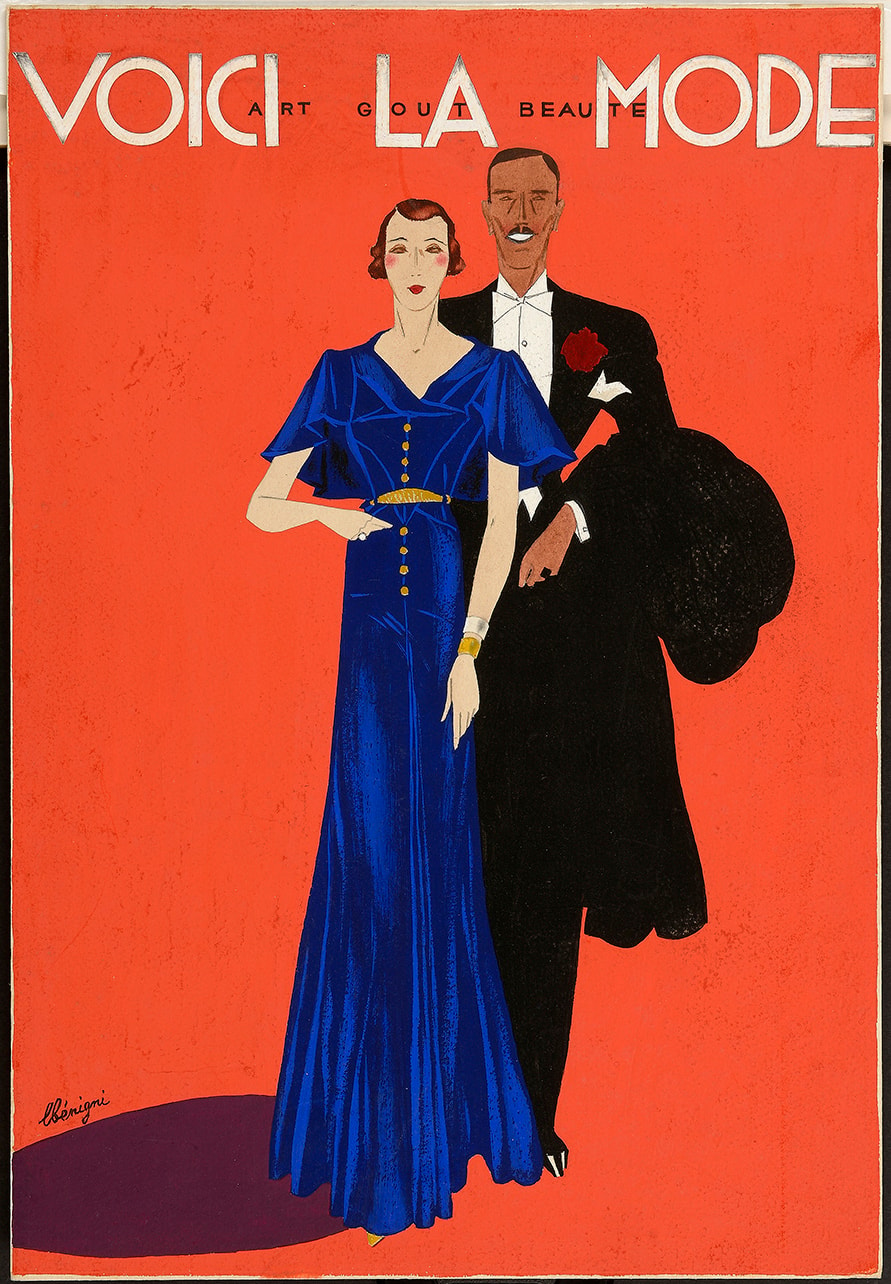Léon BENIGNI
( 1892 - 1948)
An Elegant Couple: Design for the Cover of the Magazine Voici La Mode / Art Goût Beauté
Gouache and black ink, over an underdrawing in pencil, on paper laid down on board.
Signed lbénigni at the lower left.
Inscribed VOICI LA MODE and ART GOUT BEAUTE at the top.
Further inscribed chanel and Brun Rouge / soulin on the reverse.
326 x 225 mm. (12 7/8 x 8 7/8 in.)
Signed lbénigni at the lower left.
Inscribed VOICI LA MODE and ART GOUT BEAUTE at the top.
Further inscribed chanel and Brun Rouge / soulin on the reverse.
326 x 225 mm. (12 7/8 x 8 7/8 in.)
The monthly magazine Voici La Mode / Art Goût Beauté was launched in 1920 under the title 'Les succès d’Art Goût Bon Ton.' By October 1921, however, the title had been changed to Art Goût Beauté, taking the initials of its founders, the Lyonnais textile manufactory Albert Godde Bedin et Cie. Aimed at an affluent clientele, the magazine sought to promote luxurious fabrics and fashions to a readership who could afford to dress in the French haute couture fashions of the time. Presenting the designs of the most sought-after Parisian couturiers – including Jeanne Lanvin, Lucien Lelong, Jean Patou, Paul Poiret and the House of Worth - Art Goût Beauté’s artistic director Henri Rouit commissioned drawings from the leading illustrators of the day, notably George Barbier, Paul Iribe and Georges Lepape. Each issue was rich in both advertisements and colour illustrations, some of which were tipped-in. The magazine began incorporating photography in the 1930s, and in 1933 the title was changed again, to Voici La Mode / Art Goût Beauté, with each issue illustrated only with black and white illustrations.
The woman in this gouache drawing is wearing a dress designed by Coco Chanel (1883-1971).
The woman in this gouache drawing is wearing a dress designed by Coco Chanel (1883-1971).
A leading fashion illustrator, draughtsman and lithographr, Léon Benigni worked with such designers and couturiers as Jeanne Lanvin, Marcel Rochas, Elsa Schiaparelli, Lucien Lelong, Jacques Fath, Jean Patou, Nina Ricci and Cristôbal Balenciaga. He produced drawings and cover designs for such magazines as Harper’s Bazaar, Femina, La Donna, Art Goût Beauté, The Bystander and Modes et Travaux, and also designed a number of travel posters in the 1920s and 1930s (notably one for the spa and ski resort of Brides-les-Bains in the Savoie region) and advertisements for Cadillac and LaSalle cars.
In an appreciation of Léon Benigni, published in an English magazine article in 1933, it was noted that ‘M. Benigni is known to thousands through the medium of the leading fashion magazines. This young Frenchman has brought himself to the front rank of modern fashion artists. He has developed a style which fits perfectly with present ideas of fashion. Modern fashions contain an element of caricature, though they never lose their delicacy and charm. These qualities are apparent in Bénigni’s work. In avoiding heaviness and an exact representation, he works in line, and his line work is light and suggestive enough in its simplicity to hold all the attraction so necessary in publicity. The female face is depicted almost as a formula of design. The thin lines in which it is traced are not an accurate representation, but it is impossible to deny the conviction of reality carried by the design…an addition or alteration to any of these drawings of Bénigni’s, in the form of a few extra lines or corrections, would ruin the effect. They are, for their purpose, complete as they stand.’







